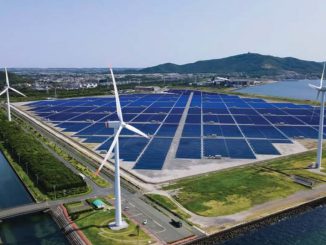The Ministry of Power recently notified the Green Open Access Rules, 2022, lowering the limit for open access transactions from 1 MW to 100 kW for green energy, simplifying the procedure for open access, and enabling faster approvals. While these rules are being seen as a game changer for green open access in the country, there are still a few concerns. Industry experts share their views on the key hits and misses of the new rules as well as the strategies and measures needed for smoother uptake of green open access. Excerpts…
What are the key hits and misses of the Green Energy Open Access Rules, 2022? How are these expected to change the green open access market in the country?

Dr Somit Dasgupta
There is no doubt that the green open access rules will stimulate demand for renewable power on the open access route, especially due to the fact that the eligibility condition for obtaining open access on the renewable route has been lowered from 1 MW to 100 kW. A large number of commercial and industrial (C&I) consumers who bear the brunt of cross-subsidy will find it economical to switch to the open access route. In some states, C&I consumers pay a tariff of Rs 12 per unit in the highest slab. They would gain a lot by paying a renewable tariff of Rs 2.50 per unit instead and a cross-subsidy surcharge (CSS). This move will definitely help in building more renewable generation capacity.
However, this move may weaken the financial condition of the discoms further since a large chunk of their subsidising consumers will move out of their billing fold and only subsidised consumers will be left with the discoms. Financially weak discoms cannot attract investors to put in their money into generation projects. As it is the accumulated losses of discoms stood at about Rs 5 trillion in March 2020, equivalent to 3.5 per cent of our GDP for 2019-20. Each unit of energy sold results in a loss of 60 paise for the discoms. There is a mammoth investment requirement for achieving a non-fossil generation capacity of 500 GW by 2030. To reach the magical figure of 500 GW, we would need to ramp up our renewable capacity from about 10 GW per year to about 40 GW per year, for the next eight years.
This is going to be an extremely difficult task and ballpark figures suggest that we would need incremental investments to the tune of Rs 13 trillion. This is the investment requirement assuming only solar capacity will be added henceforth. If part of the capacity will come from wind generation, the investment requirement would go up further.
What will be the net effect of these rules, one will have to wait and watch. The negative effect of the declining financial position of the discoms may outweigh the positive effect of capacity addition because of higher demand for renewable power from C&I consumers on the open access route.

Deepak Krishnan
In my view, the Green Energy Open Access Rules, 2022 are a potential game changer for the Indian power sector. The following are the key hits:
- The reduction of the open access limit to 100 kW. This creates new opportunities for smaller electricity consumers, especially small businesses, which are looking to purchase renewable energy. This is critical as they try to respond to their investors and buyers that are increasingly demanding greening of the supply chain.
- An opportunity for discoms to retain consumers within their network and avoid the migration of consumers. In addition, there are reasonable restrictions on open access transaction amendments to avoid high variation in demand for the discom.
- By recognising the role of green hydrogen and green ammonia in meeting the renewable purchase obligations (RPOs), the rules go a step beyond electricity-related adoption of renewable energy.
- Certainty as far as CSS is concerned. The rules have waived additional surcharge if the consumer is already paying fixed charges.
Some of the misses are:
- Issues of legacy power procurement arrangements. Even if discoms are willing to contract new renewable energy to supply to consumers, they will be hesitant as they could be saddled with these pre-committed costs.
- While the support to green hydrogen and green ammonia is warranted, a wider definition of green energy could have been considered. For example, solar thermal. This is essential given that the next big challenge in decarbonisation is going to be from hard-to-abate sectors like industry, transport, shipping and aviation.

Pulipaka, Chief Executive Officer, National Solar Energy Federation of India
Subrahmanyam Pulipaka
The Green Energy Open Access Rules are a blessing for renewable energy generators in the country as they have addressed the key concerns of renewable energy developers. Previously, open access applications took anywhere from three months to a year with some states being extremely reluctant to grant open access. The new rules ensure that open access applications will be approved within 15 days, failing which the applications will be deemed to be approved. Furthermore, the new rules have lowered the eligibility of consumers to 100 kW, which will drive demand generation as well as the switch to green energy in the country. The new energy banking rules further ensure that renewable energy generators can avail of banking services and further improve their ability to meet their contracted generation and transmission requirements.
The removal of open access charges, barring a few, is another welcome move as it will bring down the landed cost of electricity generated from renewable energy and facilitate the transition to clean energy. The exemption of CSS and additional surcharge on electricity used for the production of green hydrogen and green ammonia is set to increase the domestic production of green hydrogen and ammonia.
While the rules are incredibly progressive, they have failed to address the issue of waiver of interstate transmission system (ISTS) charges and how the state governments and agencies will be brought on board for smooth implementation as the state discoms stand to lose a huge chunk of their revenue because of these reforms. States have the power to block the implementation of these rules and this has to be addressed.
The Green Energy Open Access Rules are expected to make green energy more accessible to micro, small and medium enterprises (MSMEs) and big industries. With a lower eligibility threshold, more and more MSMEs and industries will push up the timelines for their switch to renewable energy.

Sharad Pungalia
The Green Energy Open Access Rules, 2022 hold the power to provide the necessary impetus to India’s solar sector. However, Section 42 of the Electricity Act, 2003, grants the state electricity regulatory commissions (SERCs) the jurisdictional powers to determine open access charges and open access eligibility capacity limits for their respective states. Hence, the actual implementation of the Green Energy Open Access Rules depends on how the states will align with these rules.
While there are many positive steps, a few clauses need clarity. For reference, the rules propose a defined percentage of monthly banking of unused power for all states, which is an excellent step considering many states have been restricting renewable energy banking. However, a further clause disallows the carry forward of banked energy from one month to another, which becomes discouraging, as it might prompt the states that already provide annual renewable energy banking to switch to a monthly banking system. Apart from this, the proposed determination of open access charges as specified in the rules and the appointment of the load despatch centre (LDC)/state transmission utility/central transmission utility as the nodal agency for green open access are reasonable steps. The latter can help reduce the influence of discoms in the open access approval process.

Vaibhav
The Green Energy Open Access Rules, 2022 have opened the doors for smoother implementation of open access and allowed consumers with a sanctioned load/ contracted demand of 100 kW or more to avail of open access, which was earlier set at 1 MW. This creates an opportunity for small- to medium-scale commercial users to avail of open access. Open access used to be a time-consuming and translucent process, and to consumers’ respite, the rules have attempted to bring in transparency with a defined timeline of 15 days. Applications will be managed by the central nodal agency through a national portal. On July 13, 2022, Power System Operation Corporation Limited (POSOCO) was appointed as the nodal agency for facilitating green open access and a draft procedure for the grant of green energy open access was issued.
The CSS, which used to be a considerable cost for consumers in some of the states, has been restricted to 50 per cent for 12 years from the commercial operation date of the generating plant. Besides, the rules allow a uniform RPO for all the obligated entities in the area of a distribution licensee, and green hydrogen/green ammonia for the fulfilment of their RPO. It also promotes the production of green hydrogen and green ammonia by exempting CSS and additional surcharge on such projects. The rules also safeguard the interest of the discoms by binding the applicants to avail of open access for at least one year. Thus, discoms can plan their power procurement accordingly.
While the increase in CSS has been capped at 50 per cent for 12 years from the date of commissioning of the project, a provision of the National Tariff Policy, 2016 seems to have been missed. The policy puts forward the limit of cross-subsidy to be +/-20 per cent of the average cost of supply. In the Open Access Rules 2022, it is unclear if this can be achieved or not.
What are the necessary measures required for the smoother uptake of green open access?
Dr Somit Dasgupta
One needs to bear in mind that the laying down of policy is one matter and its actual implementation is another. The implementation has to be done by organisations on the ground. One of the reasons why open access as a policy has not been successful is the fact that the state load despatch centres (SLDCs) have been pointing out technical constraints that are creating roadblocks. The fact is that the states do not want the power to flow outside their boundaries. Citing technical reasons is only a ploy. Even an organisation as mighty as Indian Railways cannot get open access easily in some states to the extent that it is contemplating whether it should set up its own transmission lines. That being the case, can individual organisations succeed in getting clearance from the SLDCs for their open access applications. There is a good possibility that despite these rules, the actual situation on the ground may continue to be the same.
Deepak Krishnan
- The identification of a nodal agency and creation of a transparent registry to track applications – the first part has already been done with the appointment of POSOCO.
- The regulators now need to get to work on defining and freezing the CSS to provide certainty.
- There is a need to work with the state energy departments and discoms to unburden them from legacy power
- purchase agreement (PPA) arrangements. The process needs to be fair to the people who have put their money into these projects as well as to the surrounding communities and employees.
- There is also a need to work with the discoms to develop offerings for them to retain consumers, especially C&I consumers. This does not directly relate to open access, but increases the choices for consumers.
Subrahmanyam Pulipaka
For the successful transition to clean energy, it is important that green energy open access is implemented with great efficiency. The SERCs will play a pivotal role in the smooth uptake of the new rules along with the state governments as electricity itself is a state subject and states have the power to legislate on it. The state regulations and rules related to open access, grant of connectivity along with the deviation settlement mechanism regulations have to be amended to accommodate the new rules for smooth uptake.
Sharad Pungalia
As mentioned, the impact of the green open access rules depends mainly on correct and timely implementation. There could be resistance from the discoms given the risk of losing high-paying C&I customers, adversely impacting their revenues and increasing the cross-subsidisation requirement. A relook at how electricity subsidy is disbursed is emerging as a prominent and necessary step in this regard. If we are to achieve any significant reform in the power sector, discoms must be freed from states’ subsidy programme. Apart from dragging discoms deeper into financial distress, the issue of subsidy and the resulting cross-subsidy charges has held back India’s adoption of distributed renewable energy.
Vaibhav
The green open access rules and regulations on general network access (GNA) to facilitate non-discriminatory open access to generating companies for ISTS have been notified in 2022. The GNA regulations allow projects with a capacity of 50 MW or above to avail of deemed connectivity under open access, whereas the green open access rules allow projects with 100 kW and above to avail of open access. Thus, it can be inferred that projects between 100 kW and 50 MW will still need to avail of open access as per the prevalent rules and support applicable under GNA will not apply to such projects. However, a clarification in this regard can help stakeholders. Further, the rules have put the responsibility of tariff determination on the appropriate commissions, which will be based on the average pooled power purchase cost, the CSS and service charges, etc. However, a guideline detailing the procedure of tariff determination would help consumers assess the likely cost of green energy and plan the purchase accordingly.
While the green open access rules ease the process of application and approval, it would be important to onboard all the stakeholders such as regional and state LDCs and state discoms through a common forum to disseminate the implementation procedure and grant connectivity modalities to facilitate timely approval and subsequent connectivity for open access.
It would be important for the SERCs to realign the state-specific open access regulations with the central rules and facilitate similar support. Otherwise, a lot of confusion and uncertainty would be created amongst the stakeholders, hampering the effectiveness of these rules.
The CSS has been capped at 50 per cent for 12 years from the date of commissioning for green energy projects; however, there is no clarity on open access availed through conventional energy projects. It would be important to clarify whether the same CSS will be applicable on all projects or there will be a separate CSS for green energy projects.


